
|   |

|   |
A slice of Music Academy of Madras at Kennedy Centre, DC - Dr. Sunil Kothari e-mail: sunilkothari1933@gmail.com Pics: Olejo Pesce October 19, 2013 For three days from September 20 till 22, the Kennedy Centre in Washington DC turned into the Music Academy of Madras for the lovers of classical Indian dance and music. Never-say-die aficionado Dr. Sreedhar Potarazu's Vital Spring Health Care has been collaborating with The Music Academy for the past seven years for the annual Dance Festival. He had a dream of mounting Utsav, a celebration of India's maestros of music and dance with artistes selected by the Music Academy. His dream came true when the Academy finalized the various details. Speaking during the inaugural function, the President of the Academy, N. Murali said, “The 80 year old institution has been a landmark in the history of classical Carnatic music and dance. In December 'Season,' the city holds more than 2000 concerts in 25 days. Nowhere in the world are such concerts held like this in a time frame. The Academy has played an important role. For the past seven years in collaboration with Dr. Sreedhar Potarazu, the Academy has started an annual festival of classical dance. Today in America, both classical Carnatic music and dance have taken firm roots. Not only the Indian immigrants settled here but also the second generation and the Americans have shown great appreciation for these arts. Therefore, it was decided to organize Utsav in collaboration with Sivam Inc., a local organization headed by Dr. Sreedhar Potarazu, in Washington DC at a venue like the Kennedy Centre featuring brilliant musicians and dancers from India. The resident Indians and Americans shall have a taste of the atmosphere of 'the season' with this initiative.” Dr Sreedhar Potarazu expressed his planning in select few words. “Our cultural heritage has acquired great status among world cultures. America has seen its growth and development. I had a dream that our artistes deserve to perform at a venue which brings connoisseurs from world over to savor the best in music and dance. We have to provide them a venue with the reverence they deserve. Not in some school auditorium or some make shift venues, but a venue which offers an ambience that world class arts generate. I am indeed grateful to the Music Academy for sharing this dream. This is the beginning. In the coming years, I hope it becomes an annual feature.” Sharing his views, industrialist Ajay Royan of Silicon Valley fame, recalled his childhood spent in Tanjore, visits to Brihadeeshwara temple, the classical arts he relished there and even after settling in America, his visits to Tanjore bring him a great feeling of pride. “We need to establish this festival. Support from Peter Teo and others is an implicit compliment for our arts.” The Terrace Theatre of the Kennedy Centre where Utsav was held resounded with warm applause. It was indeed a historic moment. The artistes selected by the Music Academy of Madras were Carnatic vocalists Ranjani and Gayatri - both are vocalists as well as violinists; the legendary violinist late Lalgudi Jayaraman's son and daughter Lalgudi G.J.R. Krishnan and Lalgudi Vijaylakshmi for Carnatic violin duet. For classical dance, Kathak dancer Aditi Mangaldas from New Delhi, a disciple of Kumudini Lakhia and Pandit Birju Maharaj; for Odissi, from Nrityagram, Bangalore, Surupa Sen and Bijayini Satpathy, disciples of Guru Kelucharan Mohapatra; and for Bharatanatyam from Los Angeles/Chennai, Mythili Prakash, disciple of Viji Prakash and currently taking further training under Malavika Sarukkai. Besides the recitals of dance and music, there were morning sessions for two days on Carnatic music and classical dance in North America. The participants were a galaxy of musicians and scholars. For the first day on Sept 21, speakers were Lalgudi G.J.R. Krishnan, Dr. Pasalai N. Aruna, former President of Carnatic Music Association of North America (CMNA) and Madurai R. Sundar, senior vocalist and teacher. For dance, speakers were Hema Rajagopalan, artistic director, Natya Dance Theatre from Chicago, Dr. Mark Kittlaus, Doctor of Professional Studies, independent scholar, from Winchester, VA, and Raji Venkatesan, organizer and former President of Sruti of Philadelphia. The next day's topic was 'Theory and Practice - A bridge.' The speakers were N. Ravikiran, the renowned musician, composer and scholar, Dr B. Balasubramaniam, Adjunct Assistant Professor of Music, Music Department, Wesleyan University, and Dr Mathew Allan, Professor of Music, Asian Studies, Wheaton College, Boston. For dance, the speakers were - author of Nityasumangali, Dr. Saskia Kersonboom, Associate Professor of Theatre Studies, University of Amsterdam, Dr. Uttara Asha Coorlawala, Adjunct Professor of Dance, Barnard College, Columbia University, New York, and Surupa Sen, Artistic Director and choreographer from Nrityagram. For music the moderator was T.M. Krishna and for dance Priyadarsini Govind. The panel discussions were held at Key Bridge Marriot Hotel where all artistes and scholars were staying. The morning sessions allotted one hour each for music and dance. The admission to the panel discussions was free. Soon after the discussion sessions, the music recitals were held at 2pm at Terrace Theatre, Kennedy Centre, followed by dance performances at 7pm. Though it was back to back and quite a tight schedule, it generated an atmosphere which one used to experience in Chennai at the Music Academy. I often felt that the venue was different but there was similar excitement as so many musicians, dancers and scholars had gathered together. Two years ago in 2011, The Kennedy Centre had mounted, as per their planned program, a month long festival of Indian arts titled 'Maximum India' with performing, visual, plastic arts and a mindboggling variety of performances of theatre, folk dances, music recitals, including popular Indi rock music, discussions on literature, films, screening of films, exhibitions of fans from collection of painter Jatin Das, of saris of India, of paintings and sculptures, and literally turned Kennedy Centre into a mini India with its multiple venues. There was an overwhelming response from Indians settled in America and all venues were full to the capacity. The Americans had started complaining about not getting tickets, as the Indians settled in America and the second generation had turned up in such large numbers that the organizers at the Kennedy Centre were at a loss as to how to accommodate Americans for whom this was the most important exposure to Indian arts. Thus after two years when Utsav was mounted, the atmosphere was right for the festival. Also it spoke volumes for the appreciation of classical dance and music which found its rightful place in mainstream arts. Now, no more Indian classical music and dance are categorized as 'ethnic' as was the case a few years ago. The quality of classical music and dance were appreciated and understood as that of world class. As a matter of fact, the media has been very active covering Indian classical dance and music, giving due place with informed criticism. That has helped both resident Indians, those also born in USA, the second generation and Americans to view them in correct perspective. As a matter of fact, the chief dance critic of The New York Times, Alastair Macaulay, makes it a point to visit India, make study of Indian classical dance forms and for past four to five years has been writing critical reviews giving a lot of space to Indian performances in the pages of The New York Times. This has indeed helped classical dance gain support from large audiences. I had attended Maximum India festival for a month and had become familiar with the organizers, officers and also some of the ushers and it was like coming home again. (See my column in narthaki.com for detailed review of Maximum India.) The panel discussions generated enthusiasm among the participant speakers. T.M. Krishna as moderator had planned to ask each one a question to frame the perspective. His moderating was incisive and provocative. Though it spilled over in terms of time, the discussions became more interesting and also provocative, with the result that for dance, less time was left and people had to rush for lunch to catch up with music recitals. On the first day of panel discussion, the book on Lalgudi Jayaraman was released - The Musical Journey of Lalgudi Jayaraman written by Lakshmi Devanathan and published by Harper Collins. She had recorded 250 hours of interview with the great maestro. The autobiography of more than 450 pages and a CD attached to the publication, the soft copy, was seen by Lalgudi before he passed away. The book covers the ancestral history of Lalgudi legacy. Lalgudi G.J.R Krishnan and his sister were deeply touched by this gesture on part of the organizers of Utsav, to have its American release. Introducing the topic, T.M. Krishna spoke of half a century of Carnatic music which South Indian community settled in USA has preserved, and it was time to examine it in its historical, social context. With the baggage of 1950s and vis-a- vis its counterpart the Hindustani music, its popularity, cultural practices being unique, it would be interesting to see how its future would be in North America. There are different cultural contexts, like European and Indian. South Indian context, as a sociological context but, it was emphasized that not as replicated in another part of the world. The panel discussions of both music and dance have been planned to be published after editing the transcripts. I shall refer to few points regarding dance, as under Asian Cultural Council Fellowship, I had studied few cases of Indian Diaspora and their attempts to establish classical dance institutions in few major cities in USA. The scenario for classical Indian dance and music in USA has changed during last two decades. Gone are the days when Indian dancers performed in auditoriums of schools and private residences. Indian Diaspora has made good economically and the second generation learning dance and music has shown serious interest in mastering these arts. As Dr. Uttara Asha Coorlawala observed, “There are better facilities now available to them to learn dance and music. The visiting gurus and dancers offering workshops, help these youngsters to grasp the best of the technique. The technological advances of videos, skype, recordings, literature all have contributed in a large measure to sustain the interest.” Visits to India, in particular during the 'Season' in Chennai, makes them aware of the deep roots these arts have and seeing them in right setting the core values are understood by them. Hema Rajagopalan summed up by stating that when she had arrived nearly forty years ago in USA, there were few Indians and the opportunity to perform was even rare. That too, she had to perform to taped music. Few Americans, who saw it, did not comprehend what was this classical dance form from India. After she settled down when her husband moved to Chicago, she thought of teaching a few children of Indians, along with some American children. An uphill task, which over the years, with determination and hard work she continued on weekends. Her story is similar to other Indian Diaspora dancers in other cities in USA, who began teaching in basement of their apartments. The scenario changed demographically when more Indian immigrants settled in USA, gaining economic security and 'making it good.' Over the decades the second generation took to it seriously and today some dancers have made it on par with the dancers back home in India, be it Bharatanatyam, Kathak or Odissi. Indian classical dance and music have been institutionalized in many ways by Indians settled in USA, with their non-profit making institutions. Indian dancers have been honoured by American Presidents and these arts are no more treated as 'ethnic.' The media has also displayed great interest and critics make serious efforts to learn and appreciate these arts writing about them in more informed manner. In terms of performances, the musicians lived up to their formidable reputation. The vocal music recital by Gayatri and Ranjani and violin duet by Lalgudi G.J.R. Krishnan and Lalgudi Vijaylakshmi were received warmly and with genuine appreciation by the Carnatic music rasikas in Washington DC. After their performances, when the artistes were brought to the foyer to meet members of the audience, it seemed like we were back home in Chennai when rasikas come backstage to compliment artistes after the performance. The artistic standard and level of performances of the dancers were of equally high standard. Aditi Mangaldas chose the theme of Krishna for her Kathak presentation titled 'Immersed' incorporating the traditional poetry, melodiously sung by Faraz Ahmed with clear enunciation, highlighting the beauty of literature. Technically rich, in energetic execution of tode, tukde, parans, the pure dance numbers, woven imaginatively, with flawless chakkars, she showed a sense of programming, highlighting essence of Kathak, winning rounds of applause. The tintinnabulation of one ankle bell suggesting her being immersed with Lord Krishna was exquisite. Recitation of various names of Krishna like Achyuta, Manohar, Muralidhar, Vasudev, Anant et al were apt as Sujata Vijayaraghavan (musicologist, dance expert, and a member of the experts committee of The Music Academy) observed while felicitating her. Through various names, Aditi showed how formless (aroopa) acquires form (roopa). It struck chords of high philosophy. The accompaniment by Ashish Gangani (pakhavaj), Mohit Gangani (tabla) and on flute by Devendar Raj Bhatt was complimentary to Aditi's dance. The lighting design by Fabiana Piccioli adapted and executed by Gyandev Singh was imaginative and evocative, in particular when the shadows merged into one, suggesting the merging of the devotee with Lord Krishna. 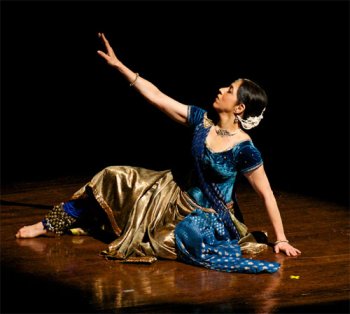 Aditi Mangaldas 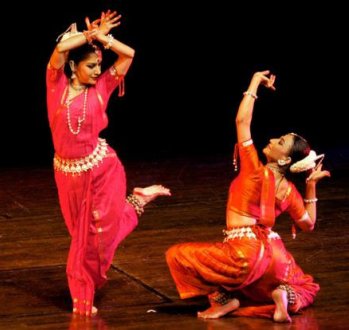 Surupa Sen and Bijayini Satpathy 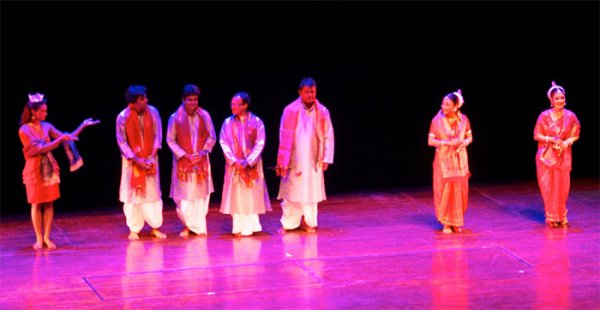 Nina Davuluri felicitates the Nrityagram artistes In Ritushringar Pallavi, the mithuna, couples in amorous postures, brought sculptures alive. The women looking in mirror, waiting for beloved, holding the door frame, sitting in postures of ecstasy, dancing in unison enhanced the feelings of shringara. The musical composition by Raghunath Panigrahi was captivating. The enactment of ashtapadi “Yahi Keshava,” go away Krishna, from the Gita Govinda demonstrated by Bijayini but performed by Surupa displayed through angikabhinaya, Radha's anguish movingly. Similarly, “Priye Charushile,” Krishna begging Radha's forgiveness performed by Bijayini had entreaties of Krishna with metaphors and similes of Sanskrit poetry taking visual form. Vibhakta, Shankaracharya's Ardhanarishwara stotra, referring to the duality of half male and half female aspects of Lord Shiva and Parvati had arresting visuals. Both characters were etched clearly, often one becoming Shiva and other Parvati, but also alternating, at times Bijayini holding pose of Shiva and later on that of Parvati, Surupa similarly enacting the two roles, merging together in seamless manner was the highlight of their presentation. Looking into each other's eyes with complete concentration they evoked a feeling of their oneness, and while dancing, sliding away into the wings, they brought the house down. The audience was eating out of their hands, so intense was their presentation. Lynne Fernandez's lighting painted their bodies and backdrops in various hues, evoking appropriate moods. The musician Jateen Sahu sang soulfully, percussionist Sibasankar Satpathy on mardala, Sanjib Kunda on violin and Parsuram Das on flute provided excellent support leaving an indelible impression. The artists were felicitated by none other than Miss America from New York, the young Indian Nina Davuluri, whose presence was lustily cheered by the audience, emphasizing that Indians settled in America and their next generation have potential and pride to make it in any field! 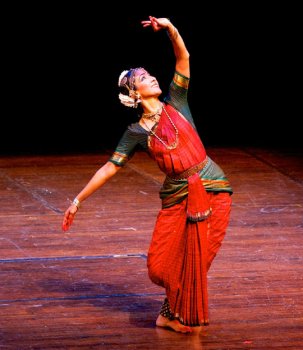 Mythili Prakash 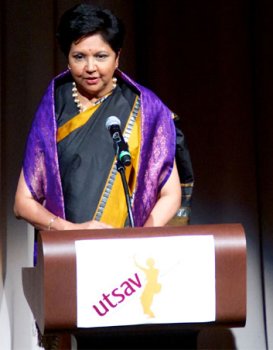 Indira Nooyi Mythili Prakash represents the second generation. Having studied from her mother Viji Prakash in Los Angeles and dividing time between America and India, currently under the tutelage of Malavika Sarukkai, she was in her element. Her joining the league of leading exponents of Bharatanatyam in India inspires the young dancers in USA. Her brother Aditya Prakash has also made a name for himself as a brilliant vocalist. Her presentation of Surya, with arresting diagonal lines of Bharatanatyam revealing the architectonic beauty of the form, the utplavanas, the elfin jumps, the split second precision with teermanams, concluding movements, showed that she is in a fine form. Her choreography of Devi evoked the benign and beatific form of the Goddess with verses familiar to the audience. Creating the iconic images lit up with lighting devised by Venkatesh Krishnan, she often looked like a bronze image of the Goddess, so powerful was the depiction. Concluding her performance with a tarana to Pandit Ravishankar's music she surprised the audience with an unconventional number to the traditional Bharatanatyam repertoire as benediction. Using Nusrat Fateh Ali Khan's music composition with lyrics by Mohammad Iqbal Naqibi, dwelling upon exalted celebration of Supreme Consciousness, Mythili danced in ecstasy, “Chand Suraj na the asman jab na tha….tab kuchh na tha yahan, tha magar tu hi tu..” (There was no moon, no sun, no sky, nothing but then O Lord you were there) and she circled with arms raised to heaven praying to the Almighty, musicians giving rhythm clapping evoking mesmerizing mood for a devotee merging with God. Mahesh Swamy's rendering the song in high pitch highlighted the moment of becoming one with God. The audience gave Mythili and the musicians Sheejith Krishna (nattuvangam), Aditya Prakash (vocal), Rajna Swaminathan (mridangam), Easwar Ramakrishnan (violin), Mahesh Swamy (flute), a standing ovation. Indian Ambassador Her Excellency Nirupama Rao, CEO of Pepsi Cola Indira Nooyi, industrialist Ajay Royan, supported the Utsav by attending it and wishing it to become an annual feature, bringing great artists from India to Washington DC, placing Indian classical music and dance on a high level. Earlier at the Kennedy Centre, there were maybe one or two evenings of sitar recital by Pandit Ravi Shankar accompanied by Zakir Hussain. Now the young generation of musicians and dancers with support from the Music Academy of Madras and Sivam Inc., of Washington DC has found their place in the sun.  Dr. Sunil Kothari is a dance historian, scholar, author and a renowned dance critic. He is Vice President of World Dance Alliance Asia Pacific India chapter, based in New Delhi. He is honored by the President of India with Padma Shri, Sangeet Natak Akademi award and Senior Critic Award from Dance Critics Association, NYC. He is a regular contributor to www.narthaki.com, the roving critic for monthly magazine Sruti and is a contributing editor of Nartanam for the past 12 years. Post your comments Pl provide your name and email id along with your comment. All appropriate comments posted with name and email id in the blog will also be featured in the site. |